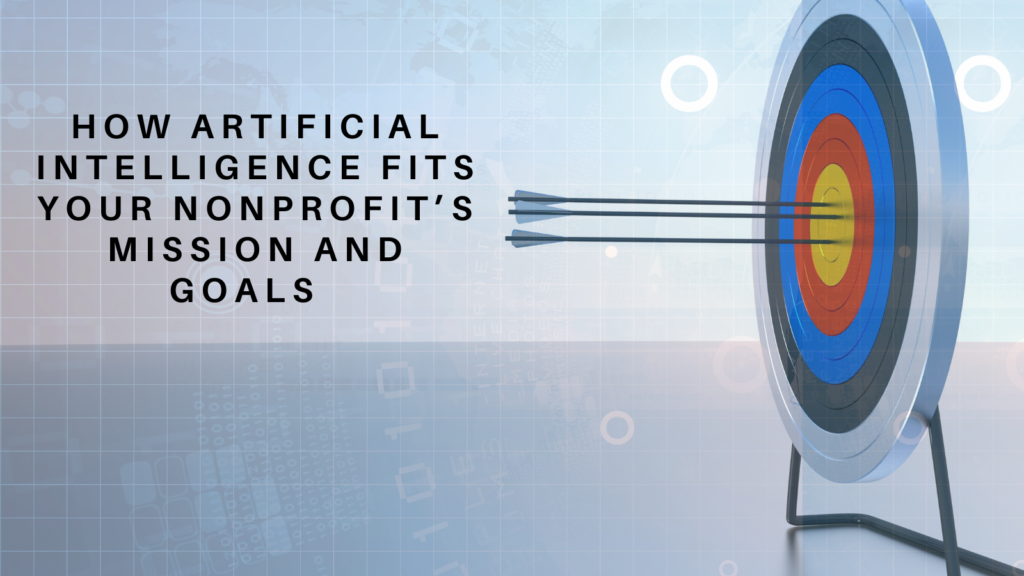
Artificial intelligence (AI) is an emerging technology that nonprofits should consider exploring and investing for the future. AI can help streamline processes and save time, especially where data is concerned. There is also the aspect of AI for fundraising that can help your nonprofit raise more money to support its mission.
Your nonprofit can work towards implementing AI by clearly defining goals on how the technology will fit into the organization’s strategy. However, it is also important to consider each nonprofit’s mission and values.
When implementing any AI technology, keeping your nonprofit’s value and goals in mind will help you avoid certain ethical pitfalls. Do remember that this technology is still young and constantly evolving, and the ethical nuances are still being discovered in several industries. Hence, understanding how AI can support your mission will make your nonprofit more resilient in the years to come.
How Does AI Support a Nonprofit’s Goals?
There are many ways that AI can support your nonprofit’s goals. Technologies like fundraising AI and intelligent softwares like Hopeful can save resources such as time and money by managing your fundraising and social media strategy.
Here are a few of the ways that AI can support your nonprofit’s goals:
- AI for fundraising that supports human fundraisers
- Better data analysis and predictions based on past trends
- Facilitate better donor journeys
- Discover new prospects for your nonprofit
- Increase staff productivity
- Optimize your nonprofit’s marketing efforts
- Increase engagement with your nonprofit’s content and brand
- Micro-target audience segments and customized content according to the audience
- Conduct mass outreach on social media and breakdown the demographics of your audience
While there may be a high upfront cost to implement AI for your nonprofit, it is important to consider how this technology will support your nonprofit’s goals in the longer run. There are many proven examples that demonstrate that the return on investment (ROI) is worth the initial costs and any implementation effort.
Defining Your Nonprofits Goals
There are many ways that AI can support a nonprofit’s mission, from fundraising to marketing, but to get the most out of this technology, you need to define your goals. Then you can decide how AI can best support your nonprofit.
Any AI technology that you implement, or a vendor you partner with should fit your nonprofit’s established goals. Trying to force your goals to fit a certain AI tool or a certain vendor may not generate efficient results.
Here are some questions you can ask yourself and your team to define your goals:
- What is your strategy to achieve your fundraising goals?
- What processes would you like to streamline so you can spend more time on identifying and interacting with your donors?
- Do you want to tailor your content for certain target audiences?
- Could data analysis help provide insights about your target audience and the content they like?
- Are you looking to grow your social media following and reach your target audience?
- Is there a current fundraising strategy that AI could help improve?
While you define your AI goals, you should also streamline your budget and timelines for implementing these tools. The right tool will fit your needs in the present and grow with your nonprofit in the future.
Deciding What Tasks Should be Performed by AI
Now that you have defined your nonprofit’s goals, it’s time to identify the tasks your specific AI tool will automate and which tasks are better performed by humans. For example, donor outreach, there are many ways that fundraising AI can support your team, but connecting with donors is best left to your fundraisers.
However, many of your fundraising and other processes can be handled by AI, especially where data analysis is involved. Fundraising AI can support your team before they connect with donors by providing data insights and predicting the potential donation ask.
A brief testing period can help determine how each technology fits into your nonprofit’s processes. Here, you may pick one process or a single area of your nonprofit’s scope of work to test AI for a limited time period. Then you can evaluate the results and make informed decisions about what works for your nonprofit and how you want to proceed with expanding AI technology throughout the organization.
AI and Your Nonprofit’s Values
It is important to consider your nonprofit’s values and when you implement any new technology. AI is no different. Keeping your nonprofit’s values in mind will help ensure that you don’t fall into ethical pitfalls throughout your AI journey.
Here is an example to consider, if an AI tool gave you visibility into another organization’s prospects and you could potentially “steal them”, would you consider it? In this case, it would probably go against your nonprofit’s values and also against the values of ethical fundraising.
Your organization’s values should be clearly defined, therefore, when ethical dilemmas arise, your employees have a clear path to proceed. An internal ethical code of conduct for your employees, board members, and volunteers can help them make decisions and keep each other accountable.
What to include in your ethical code of conduct:
- Privacy policies and data collection – what personal data is your nonprofit okay with collecting and saving
- Social media policies for content and for audience targeting
- Ethical fundraising practices – the AFP code of ethics is a good place to start
- What personal data is okay to use and how?
Identifying the right AI technology for your organization may seem like a daunting task. But when you work towards defining your goals and values, it becomes easier to see where AI fits in the bigger picture. This will help your organization pave an easier path towards implementing this technology and building a strong performance framework in the future.